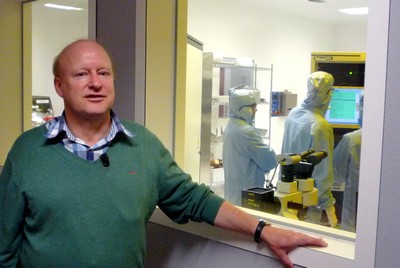Groningen researchers steer spin transport
A team of physicists from the University of Groningen led by Bart van Wees have managed to steer the transport of electron spins with an electric field. They are the first to achieve this at room temperature, bringing new applications of spintronics a step closer. Their results were published in the journal Nano Letters.

Whereas normal electronics is based on the transport of charges, spintronics is all about ‘spin’, a quantum mechanical property of electrons. A spin can have two values (up and down) and can therefore be used to process information. But you need to be able to transport the spins. And that is the hard part: electron spin subsides over time, and spin transport is through diffusion, which is not particularly efficient.
The Groningen lab recently managed to break its own record for spin transport, setting a record of 24 micrometres. This is the distance that the electron spin could cover through undirected diffusion. At the time, PhD candidate Pep Ingla-Aynés explained that the next step would be to use an electric field to direct the transport.
Success
The team has now succeeded. As in the record attempt, they used graphene, the two-dimensional form of carbon, sandwiched between layers of boron nitride, which is also two-dimensional. Without an electric field, the spin covered 7.7 micrometres, but with an electric field the maximum distance covered was a respectable 90 micrometres.
It proved possible to direct the spin to the left or right of y-shaped channels of graphene, with an efficiency of 88 percent. If you can direct spin currents you can make logic gates the building blocks of computers, for instance. As the Groningen experiments were conducted at room temperature, this is an important step towards new applications of spintronics.
Bart van Wees is a pioneer in the field of spintronics. One of his roles is as leader of the spintronics work package on the European Graphene Flagship Project. Last year he was awarded the Spinoza Prize, the highest academic award in the Netherlands, for his ground-breaking research into electron behaviour , including spin transport.
References: Josep Ingla-Aynés , Rick J. Meijerink , and Bart J. van Wees : Eighty-Eight Percent Directional Guiding of Spin Currents with 90 μm Relaxation Length in Bilayer Graphene Using Carrier Drift . Nano Letters, online 11 July 2016. DOI: 10.1021/acs.nanolett.6b01004
| Last modified: | 11 April 2017 3.20 p.m. |
More news
-
10 June 2024
Swarming around a skyscraper
Every two weeks, UG Makers puts the spotlight on a researcher who has created something tangible, ranging from homemade measuring equipment for academic research to small or larger products that can change our daily lives. That is how UG...
-
21 May 2024
Results of 2024 University elections
The votes have been counted and the results of the University elections are in!

